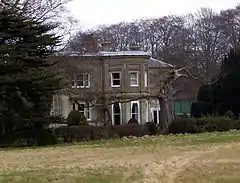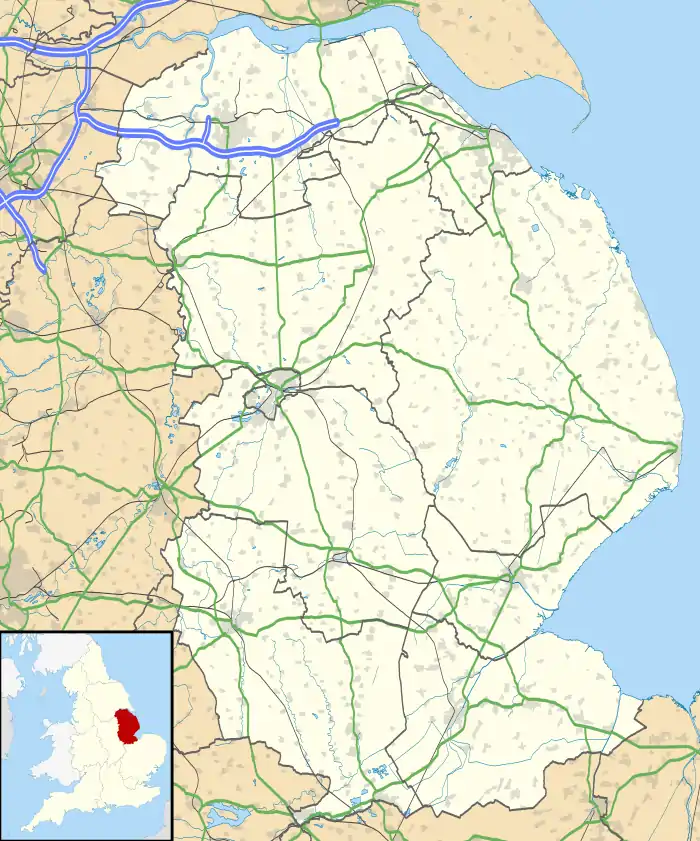| Manton | |
|---|---|
 Cleatham Hall | |
 Manton Location within Lincolnshire | |
| Population | 123 (2011) |
| OS grid reference | SE932025 |
| • London | 145 mi (233 km) S |
| Unitary authority | |
| Ceremonial county | |
| Region | |
| Country | England |
| Sovereign state | United Kingdom |
| Post town | Gainsborough |
| Postcode district | DN21 |
| Police | Humberside |
| Fire | Humberside |
| Ambulance | East Midlands |
| UK Parliament | |
Manton is a village and civil parish in North Lincolnshire, England. The population of the civil parish at the 2011 census was 123.[1] The village is situated just south from the town of Scunthorpe, and about 6 miles (10 km) south-west from the town of Brigg. The parish includes the hamlet of Cleatham.[2] Cleatham was a civil parish between 1866 and 1936.[3]
Geography

The parish church is a Grade II listed building dedicated to Saint Hybald. It was built of limestone in 1861 by J. M. Hooker, and Wheeler of Tunbridge Wells.[4]
The church was made redundant by the Diocese of Lincoln in 1998, and it was sold for residential use in 2003.[5] Its parson from 1568 was John Robotham, who was accused of missing evening prayers and even Easter communion in order to play bowls. He had a number of legal battles with parishioners, some of whom he served a summons on during church services.[6]
Cleatham Hall is a Grade II listed house dating from 1855 but with earlier origins.[7]
Cleatham bowl barrow is a Bronze Age scheduled monument located about 200 yards (200 m) to the east of Cleatham Hall.[8]
History
The last known player of the Lincolnshire bagpipes, John Hunsley, lived in Manton in the mid-1800s.[9]
Darwin family
William Darwin (1655-1682, Charles Darwin's great-great grandfather) was from Cleatham and married Anne Waring (1664-1722) of Elston in 1680, and moved to Elston. His son would be Robert Darwin (1682-1754), Charles Darwin's great-grandfather.
References
- ↑ "Civil parish population 2011". Neighbourhood Statistics. Office for National Statistics. Retrieved 19 April 2016.
- ↑ "Manton". A Vision of Britain through Time. University of Portsmouth. Retrieved 11 July 2011.
- ↑ "Cleatham". A Vision of Britain through Time. University of Portsmouth. Retrieved 11 July 2011.
- ↑ Historic England. "St Hybald (Grade II) (1346833)". National Heritage List for England. Retrieved 11 July 2011.
- ↑ "Manton". Genuki.org.uk. Retrieved 11 July 2011.
- ↑ Judith Maltby, Prayer Book and People, p.70
- ↑ Historic England. "Cleatham House (Grade II) (1083030)". National Heritage List for England. Retrieved 11 July 2011.
- ↑ Historic England. "Cleatham Round Barrow (1007729)". National Heritage List for England. Retrieved 11 July 2011.
- ↑ A commentator the 1881 Oxford Journals' Notes and queries, pp.95-96, noted that Hunsley played the pipes until shortly before his death, which occurred "between twenty and thirty years ago."
Further reading
- Manton in Kelly's Directory of Lincolnshire with the Port of Hull and Neighbourhood. With Map of the County. by E. R. Kelly, 1885
- Leahy, Kevin (July–August 2007). "A warning to the curious: digging an Anglo-Saxon cemetery". Current Archaeology. 18, No.6 (210): 26–31. Article on the excavation of the Anglo-Saxon cemetery at Cleatham, the third largest in England.
External links
 Media related to Manton, Lincolnshire at Wikimedia Commons
Media related to Manton, Lincolnshire at Wikimedia Commons